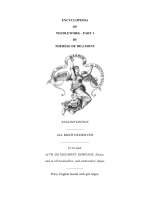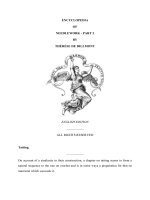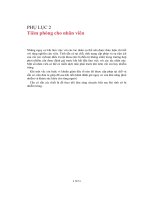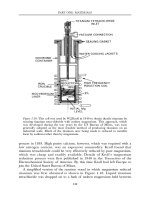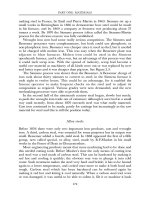An Encyclopedia of the History of Technology part 9 doc
Bạn đang xem bản rút gọn của tài liệu. Xem và tải ngay bản đầy đủ của tài liệu tại đây (115.74 KB, 10 trang )
PART ONE: MATERIALS
62
Although many arsenical copper artefacts of the Early Bronze Age appear to
have been roughly cast to shape in open stone moulds and then forged to size,
this practice died out soon after the 8 per cent tin bronze alloy came into
general use. Most artefacts were cast almost directly to the finished size in
fairly advanced closed moulds similar to that shown diagrammatically in
Figure 1.4. Many of these moulds were made from clay into which internal
cavities were precisely moulded before firing.
During the early years of the third millennium foundry processes in the
Land of Sumer appear to have developed rapidly. Before 3000 BC most of the
copper artefacts from Ur were simply fabricated from sheet metal. By 2700
BC, however, very refined cast copper articles were being produced, probably
by a version of shell moulding, using a prefired mould of thin clay. Long thin
sections, such as the blades of swords and daggers, were also cast into thin
shell moulds, which appear to have been heated to redness before the molten
metal was introduced.
By 2500 BC the Egyptians had developed considerable expertise in the
production of hollow copper and bronze statuary. Many large Egyptian statues
were cast with an internal sand core, which is still present in some of the figures
which have been found. Smaller components, such as the spouts of copper water
vessels, were undoubtedly made by the cire perdue (‘lost wax’) technique, which
had obviously been mastered by Egyptian craftsmen before 2200 BC.
Grecian bronze
Daggers with bronze blades inlaid longitudinally with niello, a black
compound of sulphur with copper or other metals which formed a background
for lively and naturalistic pictures in gold and silver, figured very prominently
in the grave goods found by Schliemann in 1876 when he opened the Royal
Bronze Age tombs of Mycenae. Such weapons, and most of the other
metalwork which was found, are now believed to be of Cretan origin. The
shaft graves date from the sixteenth century BC and are therefore of the Late
Bronze Age, the absolute chronology of which is now well established.
By the beginning of the second millennium BC, Crete was beginning to
obtain tin from Etruria and southern Spain, and their designs for spear heads
and daggers were widely copied throughout the ancient world. The
characteristic metal artefact of Crete was the double axe, an object of great
ritual significance; the compositions of some of which range from pure copper
to ductile 4 per cent tin bronzes, and finally to hard, brittle bronzes containing
18 per cent tin.
The Dorians, who invaded the Peloponnese from the north-east across the
Gulf of Corinth in the thirteenth century, had primitive metal working skills of
their own, and from the amalgamation of Dorian vigour and Minoan
NON-FERROUS METALS
63
sophistication eventually emerged the metallurgical virtuosity of classical
Greece. Bronze statuary soon began to demonstrate a mastery of foundry
techniques which remained unsurpassed until the European Renaissance. Such
castings represent what is probably the high peak of Bronze Age technology,
before the later domination by Rome of the classical world.
Between prehistoric times and 500 BC, bronze technology had developed in
a slow and irregular manner which does not relate in any metallurgical sense
with the Early, Middle and Late Bronze Age classifications of the archaeologist.
The major metallurgical discontinuity occurred around 1600 BC, in late
Minoan times, when large copper ingots weighing more than 30kg (661b) first
appeared, and the usage of bronze throughout Europe and the Mediterranean
region began to increase very rapidly.
The arsenical coppers and low tin bronzes hitherto employed had been
gradually displaced by bronzes containing 8–10 per cent tin, similar in their
general characteristics to those first utilized a thousand years previously at
Ur. The emergence of the full Bronze Age, in the middle of the second
millennium BC, is characterized by the almost universal employment of this
type of alloy. However, after about 1600 BC the majority of the bronzes
produced contained lead, which, in most cast objects of any intricacy, was
present in concentrations between 5 and 10 per cent by weight, and which
was added to improve casting fluidity.
Chinese bronze
The chronology of early Chinese bronze is more difficult to interpret, since
there appears to have been no specific date before which no lead additions
were made. The belief that China had little or no prehistorical metallurgical
experience probably originated because of the massiveness and mature artistic
competence of the Shang bronzes, which, having been looted from the Imperial
Graves at Yin, were the first to make an impact on the artistic sensibilities of
the West. It was assumed that the Chinese had waited until the middle of the
second millennium BC, the culmination of bronze technology in the West,
before it began, with no significant earlier experience, to produce large bronze
artefacts of the highest artistic quality. However, more than 300 metallic
artefacts dating from the period before 1600 BC have been discovered, and
bronze was being produced in northern Thailand in 2000 BC (see p. 59).
China obviously began to produce bronze and other copper alloys at an
early date. The presence in Kuangtung Province of tin deposits, both alluvial
and in lode form, might well have facilitated the process. The art of bronze
founding, which is now believed to have originated independently in China,
appears to have first been practised in the adjacent provinces of Hansu, Shensi
and Honan, where Chinese culture first began.
PART ONE: MATERIALS
64
The Shang bronzes, produced at Anyang between 1400 and 1027 BC, are
now world famous for their artistic merit and technical virtuosity (see Figure
1.5). These ritual objects, which were produced entirely by casting, were
notable for the richness of their relief patterns and also for their mass and
solidity, although some smaller wine vessels were also produced. One vessel
weighed over 1.6 tonnes and had obviously been cast in a multipart mould
made from prefired clay segments.
Most of these Shang artefacts had lead contents less than 1 per cent by
weight, and some contain negligible quantities of lead. It would appear lead
was an accidental impurity. The tin content of the alloys varies considerably,
however, in what appears to be a random manner from about 1.8 per cent to
more than 20 per cent.
The founders of Anyang could hardly have regarded tin as a rare or
expensive commodity, to be used as economically as possible. However, the
most impressive, highly decorated and least utilitarian items of Shang bronze
Figure 1.5: Bronze ritual vessel ‘Fang Ding’ Shang dynasty, eleventh century BC.
Decorated with a pattern of snakes and roundels.
Courtesy of the British Museum.
NON-FERROUS METALS
65
tend to be those with the highest tin content, and rarely contain more than half
a per cent of lead. Items of utility, however, such as weapons and
accoutrements, contain smaller quantities of tin and higher concentrations of
lead. It seems that the Shang foundrymen were well acquainted with the effects
of composition on the characteristics of the bronzes they produced. Thus when
the objective was to produce large, intricate and decorative castings which
would not be subjected to mechanical ill treatment, they preferred to use a very
high tin content, rather than a smaller quantity of lead to obtain the casting
fluidity required. When weapons were being made, however, brittleness was a
characteristic to be avoided. The tin content was then very considerably
reduced and a minimal quantity of lead added to improve the castability of the
alloy. The melting point of a binary 20 per cent tin bronze is approximately
880°C: a similar quantity of lead only reduces the melting point of copper to
1000°C. The high tin, lead-free alloys would therefore be easier to melt and
cast in large quantities and this must have been a factor which encouraged
their use in a situation where tin was plentiful and intricate castings weighing
perhaps a tonne were being produced.
Bronzes containing 20 per cent tin are invariably associated with the
manufacture of bells, and Theophilus in the twelfth century AD, following
what was obviously an age-old tradition, recommended this composition for its
purity of tone. The bell is generally regarded as being a Chinese invention,
and the cast artefacts of the Shang and Chou dynasties are associated with the
rituals of ancestor worship where music had a magical significance. It seems
possible, therefore, that the ritual vessels were expected to be sonorous as well
as artistically impressive.
The distinctive green patina of ancient Chinese bronzes has occurred by a
process of slow corrosion during the long internment of the bronzes in deep
loess of Central China. This yellow, porous, windblown, sandy clay contains a
good deal of calcareous material, which, when taken into partial solution by
circulating groundwaters, is believed to have played an essential role in the
patination process.
Greek metallurgical specifications
At a very early period the Greeks attempted to standardize the composition
and mechanical proportions of bronze. An inscribed stela found at Eleusis in
1893 provides what is probably the earliest known specification for bronze and
cites a decree concerning the manufacture of empolia and poloi, the bronze
fittings which were used for joining the drums of stone columns. The structure
involved was the Philonian Stoa, a portico which was erected around 360 BC
in front of the much older Telestrion at Eleusis.
It is specified that the contractor
PART ONE: MATERIALS
66
will use for the blocks copper from Marion, the alloy being made of twelve parts,
eleven of copper to one of tin. He will deliver the blocks clean, rigid and four-
square and will round off the dowels on a lathe as in the example provided; he
will fix them into the blocks straight, and perfectly rounded, so that they can be
rotated without deviation. Bids for the contract are to be made at so much per
mina of bronze, and the contractor will weigh out the bronze while there is
constantly present one of the building commission, either the public recorder or
the site supervisor.
It seems that the Greeks were aware of the weakening effect of lead on
bronze and preferred the binary tin-copper alloy for structural items. The
requirement in the specification that the poloi should be turned on a lathe is
also a matter of unique importance: this Eleusinian inscription apparently
provides the earliest evidence for the use of a metal-turning lathe in the Greek
mainland.
The requirement of the specification that an 8.3 per cent tin bronze
should be used for these castings shows that the fourth-century Greeks
were well aware of the effect of tin on the properties of the alloys they
employed. From the weapons which were found in the Mycaenean tombs
it is evident that metal workers, even in the sixteenth century BC, knew
exactly how much tin could be put into bronze before the alloy became
too brittle for hot or cold forging. They improved the hardness and
elastic limit of their bronze sword blades by judicious cold working, and
knew that ductility could be restored, when required, by careful
annealing. Pure copper rather than bronze was the preferred material
where high ductility was required for the manufacture of rivets and other
fixing components.
METALLURGY IN THE ROMAN WORLD
Although few metallurgical ideas or processes appear to have been truly
Roman in origin, the improved standards of living associated with the rapid
dissemination of the Roman way of life stimulated metallurgical demand,
and encouraged the rapid diffusion of improved processes and techniques
throughout the Empire. The primary metallurgical requirement of the army
was iron (see Chapter 2). Bronze, in quite formidable quantities, was needed,
however, both for military and non-warlike purposes, and coinage utilized
vast quantities of gold, silver and copper. Roman civilization also brought
with it the rapid expansion of highly organized urban life which required
large quantities of lead for plumbing. The main metallurgical innovation of
Roman times, however, was the general introduction of brass which was first
used for coinage when tin became expensive.
NON-FERROUS METALS
67
Roman copper and bronze
Well before Imperial times the extraordinary mineral wealth of the remoter
regions such as Spain, Germany and Britain became evident. The mines of
Spain provided gold, silver, copper, iron and zinc in great abundance, the
richer deposits being situated in a region known as Tartessus, twenty-five miles
north of Huelva on the Gulf of Cadiz.
At Rio Tinto (see p. 55) copper was extensively extracted in the Bronze
Age, and the Phoenicians appear to have worked the deposits for silver
between 900 and 700 BC. The Carthaginian empire was also dependent upon
silver from Rio Tinto, and the Romans worked the Tartessian mines
continuously from about 200 BC until AD 400. In Republican times the mines
were worked on a limited scale, largely for silver. Under Augustus, however,
the scale of operations increased very rapidly and deep tunnels were driven
into the main chalcopyrite body to exploit secondary veins of rich copper ore.
The mines appear to have reached their maximum output between the
second and third centuries AD. The Roman troops left Spain in AD 410, and
although the Visigoths took over the Peninsula in 475 they did nothing to
revive the mining industry, which was also largely ignored by the Moors. The
ancient Roman workings at Rio Tinto were not reopened until the middle of
the sixteenth century, during the reign of Philip II.
Rome did not begin to exploit the copper mines of Timna in the Negev (see
p. 52) until the third century AD, although working continued until the middle
of the seventh century when the Arabs invaded. Mining activity at Timna
appears to have been controlled largely by the availability of fuel, charcoal
obtained from the desert acacia.
The horses of San Marco
Most of the statuary of the Graeco-Roman world was cast in bronze. In fourth-
century Greece leaded tin bronzes were generally used although zinc found its way
into many of the later Roman bronzes, which by the middle of the second century
AD tended to contain comparable quantities of zinc and tin. The characteristics of
these alloys, which resembled those of the later gunmetals were, after all, well
known, and utilized by all practical foundrymen. Thus, their low melting points
and wide freezing ranges facilitated mould filling and helped to compensate for
any incidental deficiencies in feeding and venting arrangements which must have
been difficult to avoid when large, thin-walled castings of a complex nature were
being produced in a primitive foundry. Zinc would also have deoxidized the alloys
and assisted greatly in the reduction of casting porosity.
However, some artists of this period cast their statues from what we would
now regard as most unsuitable material. The four horses of San Marco in
PART ONE: MATERIALS
68
Venice, when accurately analysed in 1975, were found to have been cast from
virtually pure copper, containing only about 1 per cent of t1n and lead.
Because of its high melting point and narrow freezing range, this alloy would
have been difficult to melt and cast properly.
The San Marco horses were cast by the indirect lost wax process, the
technique used some 1500 years later by Benvenuto Cellini when he cast his
celebrated Perseus. In this approach, the wax layer applied to the surface of the
core is equal in thickness to the wall thickness of the casting to be produced.
The wall thickness of the San Marco horses varies between 7.5 and 10.5mm,
and originally they were gilded. From the duplex structure of the surviving
areas of the gilded layer, it can be inferred that before the application of the
gold leaf, the copper surface had been treated with an aqueous solution of gold
mercury amalgam. When this had reacted chemically on the surface of the
copper to produce the amalgamated layer required, the work would have been
heated gently and the gold leaf applied.
Theophilus, writing in the twelfth century AD, warned that this technique
could not be used to gild a lead-containing substrate, and the information
would probably have been available in Roman times. The artist who produced
the horses of San Marco might have decided to produce his castings from
copper because it was easier to gild than a bronze which might well have
contained substantial quantities of lead. They were popularly attributed to
Lysippus of Sicyon, the official sculptor of Alexander the Great, who worked
in the fourth century BC. It is possible, however, that they were cast eight
hundred years later, during the reign of Constantine, although a more probable
date would be some time during the second century AD.
Lead and silver
Lead is comparable to copper in its antiquity and was probably obtained in its
metallic form by reduction from its ore at an earlier date. The earliest known
metallic artefacts, small beads and pins of copper dating from the period between
9000 and 7000 BC, were hammered from crystals of native, unmelted copper
(see p. 48). However, at 6500 BC horizons in the ancient Anatolian mound of
Catal Hüyük beads of fused lead have been found in close association with
hammered beads of native copper. It appears that lead must have been extracted
from its ores at an earlier date than copper, especially in view of the low melting
point of lead and the ease with which its oxide can be reduced by carbon.
Native lead is rarely found. Its sulphide, however, galena, upon which most
lead ores are based, is fairly abundant and would have been instantly recognizable
by primitive man because of its lustre, high density, and by the structural
perfection of its dark grey cubic crystals. When exposed at an outcrop, galena
weathers and oxidizes. Anglesite, the sulphate of lead, is a mineral formed during
NON-FERROUS METALS
69
the intermediate stages of this reaction process which generally concludes with the
formation of cerussite, a lead carbonate. Galena usually contains between 0.03
and 0.1 per cent by weight of silver, and the economics of lead extraction are
generally determined by the value of the silver present in the ore.
Metallic lead has been found in Iraq, in a 6000 BC context at Yarim Tepe,
and at the fifth-millennium site of Arpachiyeh. Lead artefacts have also been
obtained from the fourth-millennium sites of Anan and Hissar III in Iran and
Naqada in Egypt.
The earliest evidence of lead being used for aesthetic rather than practical
purposes is provided by an Egyptian figurine 5cm high, dating from about
4000 BC, which is now in the British Museum. It is unusual in having been
carved from a solid block rather than being cast to shape; the lead is of such
high purity and contains so little silver that it could apparently have been
obtained only by reducing the oxide residues from a silver cupellation process.
Few leaden artefacts of comparable age have been found, although a mid-
fourth millennium cemetery at Byblos in Lebanon recently yielded more than
200 silver artefacts. Silver objects of the late fourth millennium have also been
unearthed in Palestine, in Ur and Warka in Mesopotamia, and also from
various sites in Asia Minor. It seems probable that they emerged as a by-
product of lead refining operations.
Lead artefacts of the third and second millennia BC include spindle whorls,
weights for fishing, and wire which appears to have been used for repairing
pottery. Lead weights, based on a unit module of 61g (2.202), have also been
found throughout the Aegean in Middle and Late Bronze Age contexts. Shapeless
lumps of lead were found in that layer of the Hissarlik ruins corresponding to the
period between 3000 and 2500 BC, and many fine silver artefacts dating from
about 2700 BC were found by Sir Leonard Woolley in the Royal Graves at Ur.
Numerous deposits of silver-rich lead are known in the Aegean area, several
of which were described by classical authors such as Aeschylus, Herodotus and
Strabo. In the fifth century BC, silver from the mines at Laurion provided the
wealth needed to support the Athenian Empire. Other famous silver mines
were those in the Pangaean region of Macedonia, and the Cycladic island of
Siphnos. Mining at Siphnos began some time between 3150 and 2790 BC.
The silver recovered from the Early Cycladic tombs appears never to have
been melted down for recycling, and this has made it possible to utilize isotope
abundance analysis to identify the lead mines from which the silver was
obtained. Specific identifications can now be made by measuring the relative
abundance of the natural isotopes in each element present in the metallic
artefact. This approach allows the origin of the major alloying constituents to
be identified, not from the impurities they contain, but from their own specific
internal atomic characteristics. The metals extracted from every ore deposit
each have an isotope distribution spectrum which is specific to, and
characteristic of that deposit. Isotope abundance ratios are not influenced in
PART ONE: MATERIALS
70
any way by smelting or refining processes, or by the presence or absence of
impurities introduced during alloying.
The silver artefacts in the Cycladian tombs, therefore, which appear to have
been made from virgin metal and almost immediately interred, have isotope
abundance ratios which make it possible to identify very precisely the lead
mines from which the silver was obtained.
Of sixteen artefacts, six were found to have come from the Laurion mine
near Athens and eight from the Siphnos field. A number of lead and silver
artefacts from the shaft graves at Mycenae (c.1550 BC) were made from metal
coming from the Laurion mine. Egyptian silver artefacts of the 10th and 11th
Dynasties (2175–1991 BC) also appear to have been made from Laurion
metal. Isotope ratio measurements on Cretan lead and silver artefacts of the
period 1700–1450 BC indicate that about 80 per cent of the metal came from
Laurion and only 10 per cent from Siphnos. Many lead and silver artefacts
were preserved under the volcanic ashes which submerged Akrotiri, on the
island of Thera, in 1500 BC. About 96 per cent of this metal came from
Laurion and only 4 per cent from Siphnos.
Rio Tinto
At this period, Rio Tinto was being worked only for copper; silver was first
exploited in this area between the twelfth and eleventh centuries BC. The
chalcopyrite ore which appears to have been worked for silver around 1200 BC at
Rio Tinto was taken from a thin, concentrated cementation layer, only a few
centimetres thick, between the oxidized gossan and the principal mass of copper
ore (see p. 55). It could have contained around 40g of silver per tonne. Up to this
time the bulk of Mediterranean silver had been derived from lead by cupellation.
Since Rio Tinto copper contained little lead, it is evident that lead oxide, or a lead
ore must have been added to the smelting charge to take up the silver. The
chalcopyrite ore might have been fused directly in a small shaft furnace to form a
copper sulphide matte, from which the silver was absorbed by molten lead, and
the alloy thus obtained would then have been cupelled to extract the silver.
The silver deposits at Rio Tinto were controlled successively by the
Phoenicians, Carthaginians and, from about 200 BC the Romans. By this time
the wealth of Tartessus, the biblical land of Tarshish, had become legendary
throughout the Graeco-Roman world.
Silver production at Laurion
Silver was extracted at Laurion from a geological formation of three layers of
whitish marble and limestones separated by two layers of micaceous schist.
NON-FERROUS METALS
71
Contact deposits of silver-bearing lead concentrated below each layer of schist.
The galena-based ore from the lower contact deposit was particularly rich and is
reputed to have yielded between 1200 and 1400g of silver per tonne in the time
of Themistocles. This was not exploited until the beginning of the fifth century
BC. Earlier mining was confined to the upper contact layer, which was closer to
the surface, and yielded ore based largely upon the mineral cerussite, a carbonate
of lead. The lower, richer contact layer in the mines was discovered in 484 BC
and 100 talents of the silver it produced were used by Themistocles to build the
fleet which destroyed the Persians at Salamis in 480 BC.
Subsequent references to the mines in plays by Aristophanes and
Pherecrates suggest that they were then operated under state control. During
the fourth century the mines and mining rights at Laurion still belonged to the
Athenian state, who auctioned off operating franchises to private contractors
and speculators. The industry declined very rapidly towards the end of the
fourth century, when the silver coinage standard of the Athenian state was
superseded by the gold standard introduced by the Macedonian kings. The last
Athenian silver tetra-drachmas were minted in the second half of the first
century BC, by which time the mines were largely exhausted, and once
prosperous mining towns such as Thorikos had been virtually abandoned.
Attempts made in the mid-nineteenth century AD to revive mining at Laurion
were unsuccessful.
The ore extracted at Laurion in the fourth and fifth centuries BC was
crushed with iron mallets and then ground to a sandy consistency in rotating
stone hourglass mills or in hopper querns. The crushed ore emerged as a fine
powder from which the lighter, earthy material was removed by water washing
in some very ingenious helicoidal washers. A continuous current of water,
during its passage around the spiral, carried the suspended particles of ore
from cup to cup and classified them. The rich ore was the first to be deposited,
then the poorer ore and finally the sand and silts. When the water reached the
lower tank all suspended solids had been deposited and it could be returned to
the stand tank, so completing the circulation process.
The argentiferous lead ore, concentrated in this way, was then taken from
Laurion to smelting complexes at Thorikos, Puntazeza and Megola Pevka,
where vertical shaft furnaces, using locally produced charcoal, were used to
reduce the ore to metal. The silver content of the lead alloy obtained from this
smelting process was subsequently recovered by cupellation, and taken to the
Athenian mint, at the south-east corner of the ancient Agora, where the famous
silver drachmas, the ‘owls of Athene’ would have been struck.
Some of the lead produced was used to a limited extent for sealing and for
holding in place the iron clamps used to prevent relative movement between
large marble building blocks. From the extensive deposits of litharge in the
Laurion, it must be concluded that the value of lead at this time did not always
justify the cost of recovery from cupellation waste.
